NCERT Solutions for Class 10 Science Chapter 10 Light Reflection and Refraction
The Class 10 NCERT Solutions for Science Chapter 10 Light Reflection and Refraction includes all the intext and exercise questions. Class 10 Science Chapter 10 Light Reflection and Refraction NCERT questions and answers help students to clear their doubts and to obtain good marks in Class 10 board exam. All the solutions provided in this article are strictly based on the CBSE syllabus and curriculum.
Class 10 Science Chapter 10 NCERT Questions and Answers
Class 10 Science Chapter 10 Light Reflection and Refraction NCERT Questions and Answers are prepared by experts with a detailed explanation that will help students complete their assignments & homework. Having a good grasp over CBSE NCERT Solutions for Class 10 Science will further help the students in their preparation for board exams and other competitive exams such as NTSE, Olympiad, etc.
NCERT Solutions for Class 10 Science Chapter 10 Intext Questions
Intext Question (Page No. 168)
Question 1: Define the principal focus of a concave mirror.
Answer: Light rays that are parallel to the principal axis of a concave mirror converge at a specific point on its principal axis after reflecting from the mirror. This point is known as the principal focus of the concave mirror.
Question 2: The radius of curvature of a spherical mirror is 20 cm. What is its focal length?

Question 3: Name the mirror that can give an erect and enlarged image of an object.
Answer: When an object is placed between the pole and the principal focus of a concave mirror, the image formed is virtual, erect, and enlarged.
Question 4: Why do we prefer a convex mirror as a rear-view mirror in vehicles?
Answer: Convex mirrors give a virtual, erect, and diminished image of the objects placed in front of them. They are preferred as a rear-view mirror in vehicles because they give a wider field of view, which allows the driver to see most of the traffic behind him.
Intext Question (Page No. 171)
Question 1: Find the focal length of a convex mirror whose radius of curvature is 32 cm.
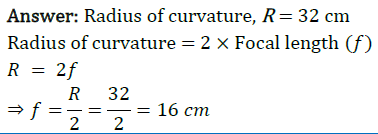
Hence, the focal length of the given convex mirror is 16 cm.
Question 2: A concave mirror produces three times magnified (enlarged) real image of object placed at 10 cm in front of it. Where is the image located?
Answer: Magnification produced by a spherical mirror is given by the relation,
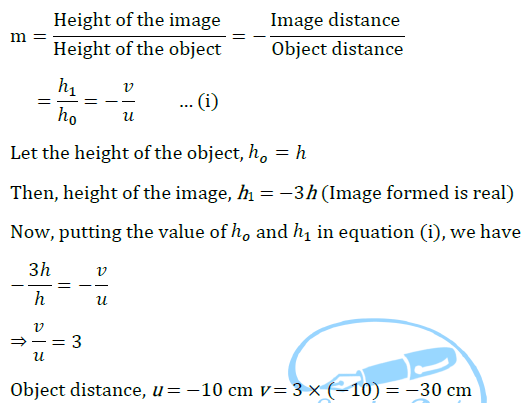
Here, the negative sign indicates that an inverted image is formed at a distance of 30 cm in front of the given concave mirror.
Intext Question (Page No. 176)
Question 1: A ray of light travelling in air enters obliquely into water. Does the light ray bend towards the normal or away from the normal? Why?
Answer: The light ray bends towards the normal. When a ray of light travels from an optically rarer medium to an optically denser medium, it gets bent towards the normal. Since water is optically denser than air, a ray of light travelling from air into the water will bend towards the normal.
Question 2: Light enters from air to glass having refractive index 1.50. What is the speed of light in the glass? The speed of light in vacuum is 3 × 108 m s−1.
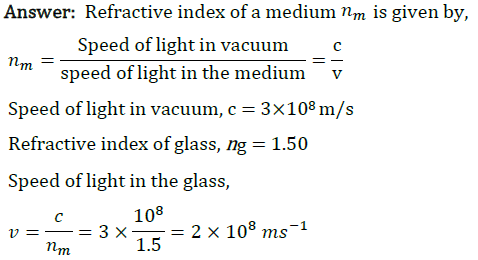
Question 3: Find out, from Table 10.3, the medium having highest optical density. Also find the medium with lowest optical density.
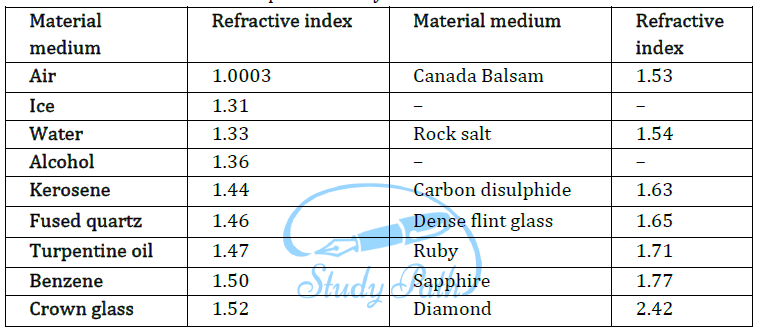
Answer: Lowest optical density = Air
Highest optical density = Diamond
The optical density of a medium is directly related to its refractive index. A medium with the highest refractive index will have the highest optical density and vice-versa.
It can be observed from the table that air and diamond respectively have the lowest and highest refractive index. Hence, air has the lowest optical density and diamond has the highest optical density.
Question 4: You are given kerosene, turpentine and water. In which of these does the light travel fastest? Use the information given in Table. (See above table)
Answer: Speed of light in a medium is given by the relation for refractive index (nm). The relation is given as
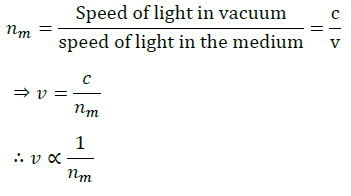
It can be inferred from the relation that light will travel the slowest in the material which has the highest refractive index and travel the fastest in the material which has the lowest refractive index.
It can be observed from table 10.3 that the refractive indices of kerosene, turpentine, and water are 1.44, 1.47, and 1.33 respectively. Therefore, light travels the fastest in water.
Question 5: The refractive index of diamond is 2.42. What is the meaning of this statement?
Answer: Refractive index of a medium is related to the speed of light in that medium by the relation:

Where, c is the speed of light in vacuum/air
The refractive index of diamond is 2.42. This suggests that the speed of light in diamond will reduce by a factor 2.42 compared to its speed in air.
Intext Question (Page No. 184)
Question 1: Define 1 dioptre of power of a lens.
Answer: Power of lens is defined as the reciprocal of its focal length. If Pis the power of a lens of focal length ‘f’ in metres, then

The S.I. unit of power of a lens is Dioptre. It is denoted by D. Therefore, 1 dioptre is defined as the power of a lens of focal length 1 metre. 1D=1m-1
Question 2: A convex lens forms a real and inverted image of a needle at a distance of 50 cm from it. Where is the needle placed in front of the convex lens if the image is equal to the size of the object? Also, find the power of the lens.
Answer: When an object is placed at the centre of curvature, 2F1, of a convex lens, its image is formed at the centre of curvature, 2F2, on the other side of the lens. The image formed is inverted and of the same size as the object, as shown in the given figure.
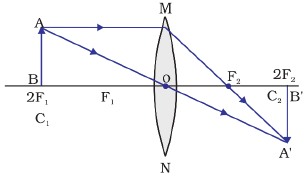
It is given that the image of the needle is formed at a distance of 50 cm from the convex lens. Hence, the needle is placed in front of the lens at a distance of 50 cm.
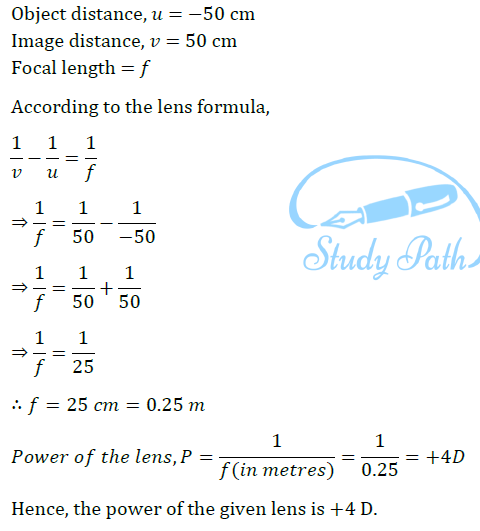
Question 3: Find the power of a concave lens of focal length 2 m.
Answer: Focal length of concave lens, f = 2 m

Here, the negative sign arises due to the divergent nature of the concave lens. Hence, the power of the given concave lens is −0.5 D.
NCERT Solutions for Class 10 Science Chapter 10 Exercise Questions
Question 1: Which one of the following materials cannot be used to make a lens?
(a) Water
(b) Glass
(c) Plastic
(d) Clay
Answer: (d) Clay
Question 2: The image formed by a concave mirror is observed to be virtual, erect and larger than the object. Where should be the position of the object?
(a) Between the principal focus and the centre of curvature
(b) At the centre of curvature
(c) Beyond the centre of curvature
(d) Between the pole of the mirror and its principal focus.
Answer: (d) Between the pole of the mirror and its principal focus.
Question 3: Where should an object be placed in front of a convex lens to get a real image of the size of the object?
(a) At the principal focus of the lens
(b) At twice the focal length
(c) At infinity
(d) Between the optical centre of the lens and its principal focus.
Answer: (b) At twice the focal length
Question 4: A spherical mirror and a thin spherical lens have each a focal length of 15 cm. The mirror and the lens are likely to be
(a) Both concave.
(b) Both convex.
(c) the mirror is concave and the lens is convex.
(d) the mirror is convex, but the lens is concave.
Answer: (a) Both concave.
Question 5: No matter how far you stand from a mirror, your image appears erect. The mirror is likely to be
(a) plane
(b) concave
(c) convex
(d) either plane or convex.
Answer: (d) either plane or convex.
Question 6: Which of the following lenses would you prefer to use while reading small letters found in a dictionary?
(a) A convex lens of focal length 50 cm.
(b) A concave lens of focal length 50 cm.
(c) A convex lens of focal length 5 cm.
(d) A concave lens of focal length 5 cm.
Answer: (c) A convex lens of focal length 5 cm.
Question 7: We wish to obtain an erect image of an object, using a concave mirror of focal length 15 cm. What should be the range of distance of the object from the mirror? What is the nature of the image? Is the image larger or smaller than the object? Draw a ray diagram to show the image formation in this case.
Answer: Range of object distance = 0 cm to15 cm. A concave mirror gives an erect image when an object is placed between its pole (P) and the principal focus (F).
Hence, to obtain an erect image of an object from a concave mirror of focal length 15 cm, the object must be placed anywhere between the pole and the focus. The image formed will be virtual, erect, and magnified in nature, as shown in the given figure.
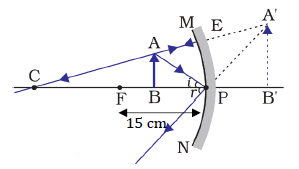
Question 8: Name the type of mirror used in the following situations.
(a) Headlights of a car.
(b) Side/rear-view mirror of a vehicle.
(c) Solar furnace.
Support your answer with reason.
Answer: (a) Concave Mirror: Because concave mirrors can produce a powerful parallel beam of light when the light source is placed at their principal focus.
(b) Convex Mirror: Because of its largest field of view.
(c) Concave Mirror: Because it concentrates the parallel rays of the sun at a principal focus.
Question 9: One-half of a convex lens is covered with a black paper. Will this lens produce a complete image of the object? Verify your answer experimentally. Explain your observations.
Answer: The convex lens will form complete image of an object, even if it’s one half is covered with black paper. It can be understood by the following two cases.
Case I: When the upper half of the lens is covered- In this case, a ray of light coming from the object will be refracted by the lower half of the lens. These rays meet at the other side of the lens to form the image of the given object, as shown in the following figure.
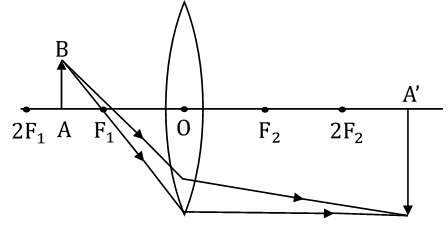
Case II: When the lower half of the lens is covered-In this case, a ray of light coming from the object is refracted by the upper half of the lens. These rays meet at the other side of the lens to form the image of the given object, as shown in the following figure.
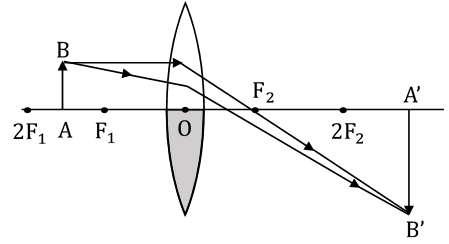
Question 10: An object 5 cm in length is held 25 cm away from a converging lens of focal length 10 cm. Draw the ray diagram and find the position, size and the nature of the image formed.
Answer:
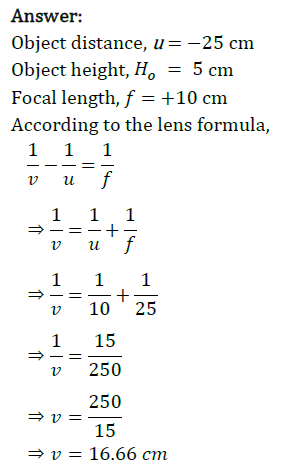
The positive value of v shows that the image is formed at the other side of the lens.

The negative sign shows that the image is real and formed behind the lens.
Now magnification,
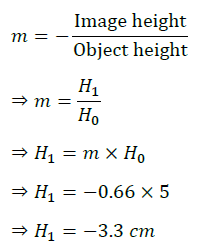
The negative value of image height indicates that the image formed is inverted. The position, size, and nature of image are shown in the following ray diagram.
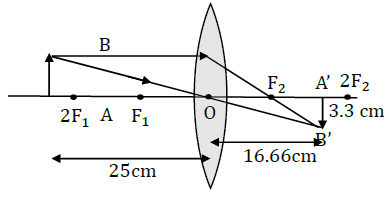
Question 11: A concave lens of focal length 15 cm forms an image 10 cm from the lens. How far is the object placed from the lens? Draw the ray diagram.
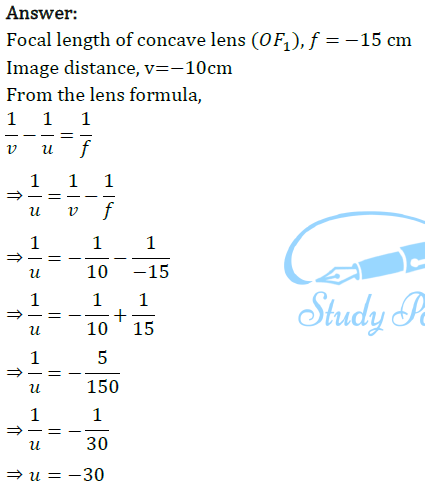
The negative value of u indicates that the object is placed 30 cm in front of the lens. This is shown in the following ray diagram.
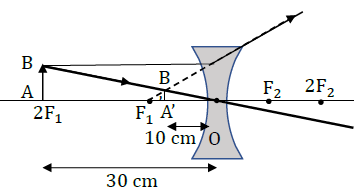
Question 12: An object is placed at a distance of 10 cm from a convex mirror of focal length 15 cm. Find the position and nature of the image.
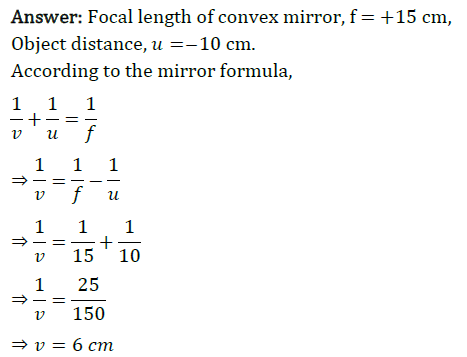
The positive value of v indicates that the image is formed behind the mirror.

The positive value of magnification indicates that the image formed is virtual and erect.
Question 13: The magnification produced by a plane mirror is +1. What does this mean?
Answer: Magnification produced by a mirror is given by the relation

The magnification produced by a plane mirror is +1. It shows that the image formed by the plane mirror is of the same size as that of the object. The positive sign shows that the image formed is virtual and erect.
Question 14: An object 5.0 cm in length is placed at a distance of 20 cm in front of a convex mirror of radius of curvature 30 cm. Find the position of the image, its nature and size.
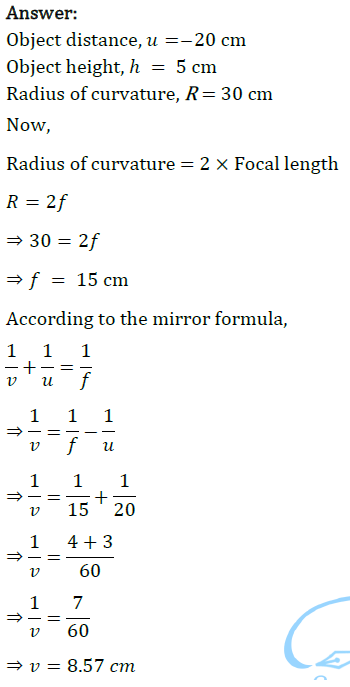
The positive value of v indicates that the image is formed behind the mirror.

The positive value of magnification indicates that the image formed is virtual
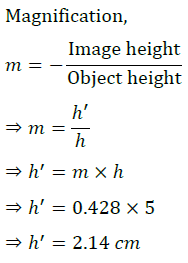
The positive value of image height indicates that the image formed is erect. Therefore, the image formed is virtual, erect, and smaller in size.
Question 15: An object of size 7.0 cm is placed at 27 cm in front of a concave mirror of focal length 18 cm. At what distance from the mirror should a screen be placed, so that a sharp focused image can be obtained? Find the size and the nature of the image.
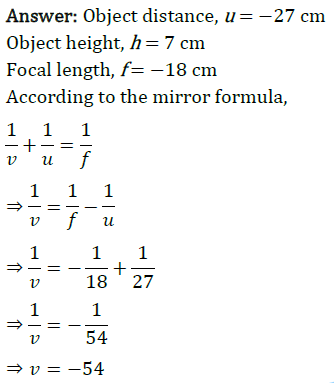
The screen should be placed at a distance of 54 cm in front of the given mirror.

The negative value of magnification indicates that the image formed is real.
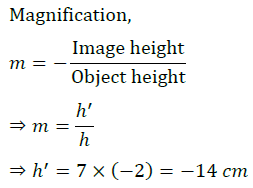
The negative value of image height indicates that the image formed is inverted.
Question 16: Find the focal length of a lens of power −2.0 D. What type of lens is this?
Answer:
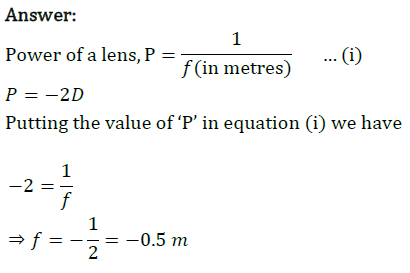
Question 17: A doctor has prescribed a corrective lens of power +1.5 D. Find the focal length of the lens. Is the prescribed lens diverging or converging?
Answer:
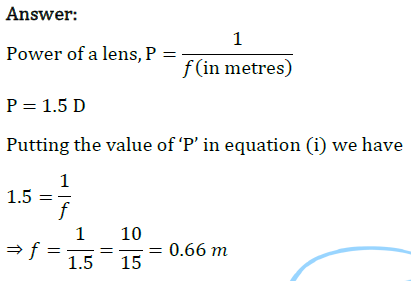
Topics covered under Class 10 Science Chapter 10 Light Reflection and Refraction
Below we have listed the topics discussed in NCERT Solutions for Class 10 Science Chapter 10. The list gives you a quick look at the different topics and subtopics of this chapter.
| Section in NCERT Book | Topics Discussed |
|---|---|
| 10.1 | Reflection of Light |
| 10.2 | Spherical Mirrors |
| 10.3 | Reflection of Light |
| 10.3.6 | Sign Convention for Spherical Lenses |
| 10.3.7 | Lens Formula and Magnification |
| 10.3.8 | Power of a Lens |
NCERT Solutions for Class 10 Science Chapter 10 – A Brief Discussion
Chapter Overview: Light has always been an interesting subject for us. In this chapter, you will learn about light and properties in detail. This chapter covers some important properties of light such as reflection and refraction. Further, it explains the spherical mirrors, image formation by the Spherical Mirror and the representation of image formation using ray diagrams. After going through the chapter, you will also get to know about the leans mirror formula and the lens formula. Moreover, the chapter also discusses the refractive index, power of the lens, magnification etc.